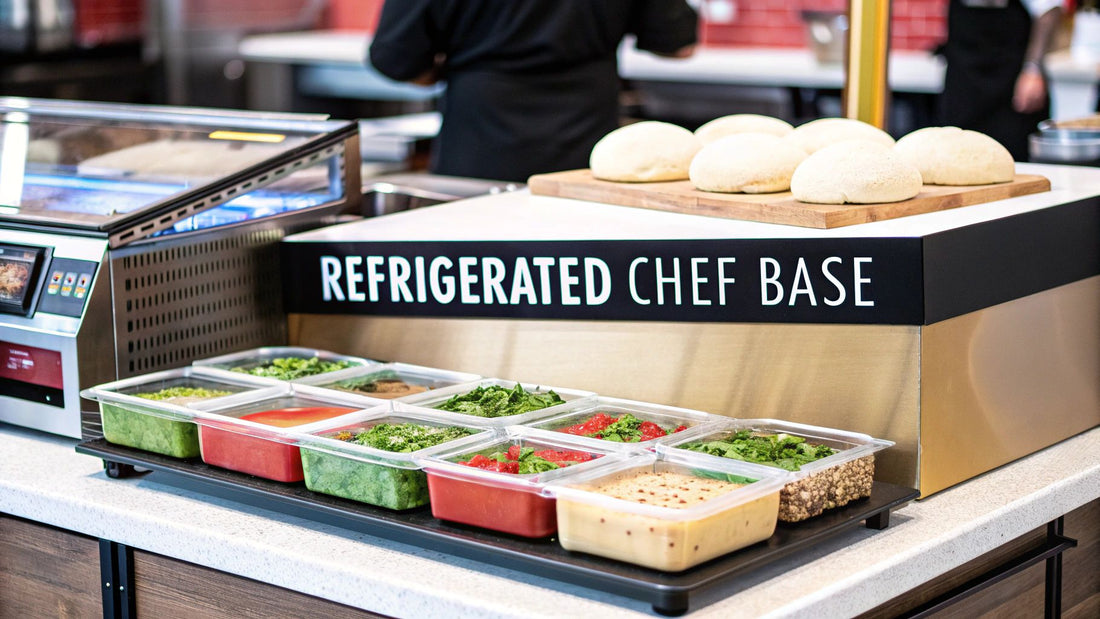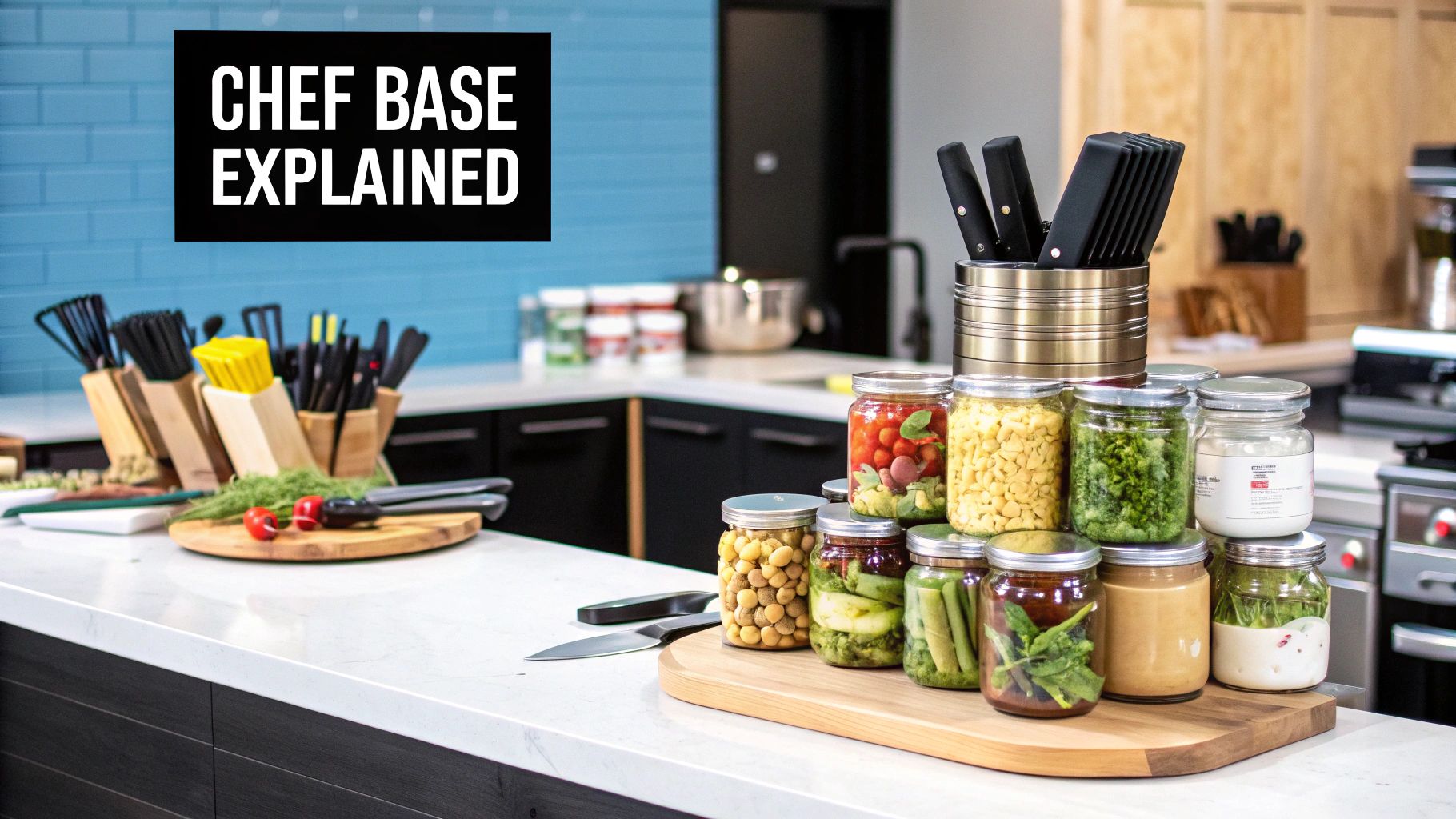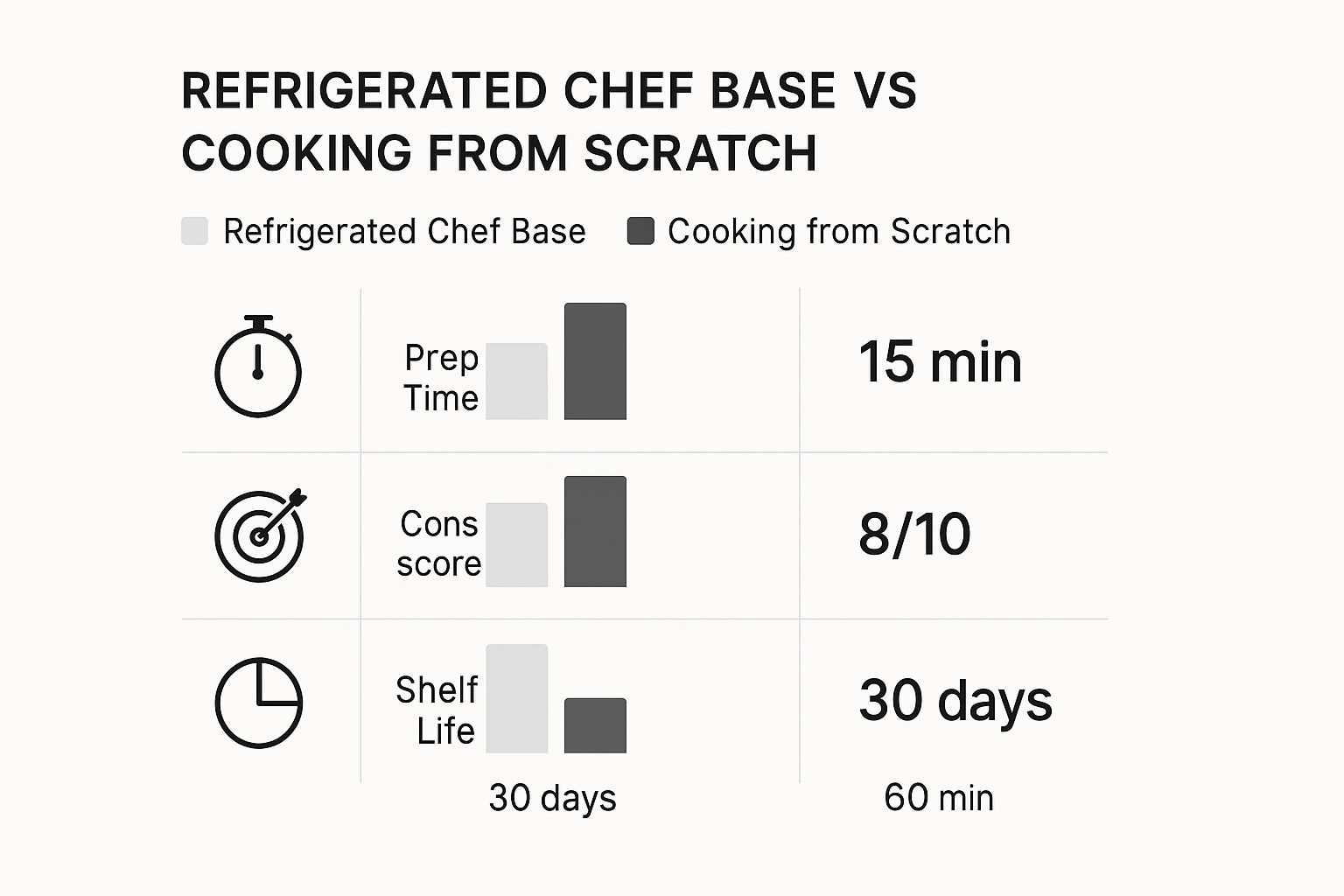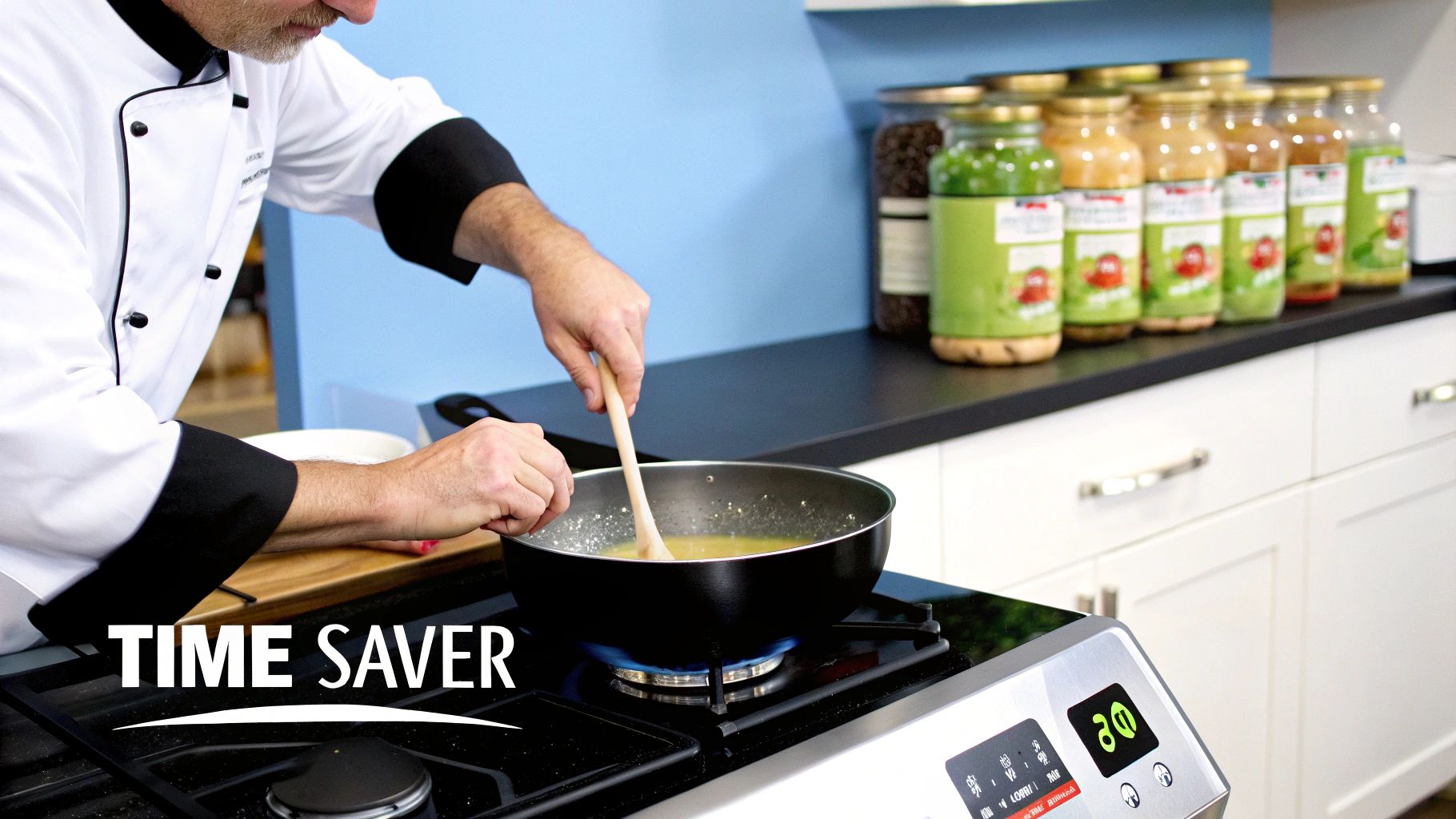
The Ultimate Refrigerated Chef Base Guide for Pizzerias
Share
Think of a refrigerated chef base as the unsung hero of a high-speed pizzeria. It’s a low-profile, heavy-duty cabinet with refrigerated drawers, specifically built to sit directly underneath your countertop equipment like a pizza prep table or even a small oven. For a busy pizzeria, this means all your essential pizza toppings—from cheese and pepperoni to fresh veggies—are kept perfectly chilled and right where you need them, creating an incredibly efficient pizza prep station.
The Secret to a Faster Pizza Prep Line

Picture your pizzeria on a slammed Friday night. What’s the difference between a smooth, profitable service and a kitchen spiraling into chaos? More often than not, it comes down to workflow and organization. This is where a refrigerated chef base proves its worth for any pizza-focused restaurant.
Don't just think of it as another fridge. See it as the solid, chilled foundation for your entire pizza-making station. It’s the "pit stop" for your culinary "race car," holding every crucial topping perfectly cold and literally inches away from where the pizza magic happens.
This setup blows traditional layouts out of the water, where pizza makers are constantly taking steps back and forth to a separate reach-in cooler. In a fast-paced pizzeria, those extra steps are killers. They add up fast, bogging down your entire production line from dough to oven.
Streamlining Your Pizza Workflow
A chef base fundamentally changes your pizzeria's economy of motion. By putting cold storage directly under the pizza prep table, it creates a powerful, ergonomic station where your team can really fly. The benefits are immediate and tangible:
- Eliminates Wasted Motion: Your pizza makers can build pies with incredible speed and precision, grabbing cheese, meats, and veggies without taking a single step.
- Locks in Food Safety: Ingredients like mozzarella and sausage stay at optimal, safe temperatures right up until the moment they hit the pizza, drastically cutting their time in the temperature danger zone.
- Maximizes Kitchen Real Estate: It cleverly merges two essential functions—a work surface and cold storage—into one compact footprint, freeing up precious floor space for other equipment or staff.
At its core, a refrigerated chef base is all about fueling your pizzeria's success during the most demanding rushes. It gives your team the power to build pizzas with speed, consistency, and confidence.
This boost in efficiency is exactly why this equipment is taking professional kitchens by storm. The global market for chef bases is on a tear, projected to jump from an estimated USD 1.2 billion in 2024 to USD 2.5 billion by 2033. This growth isn't just a trend; it's a clear signal that the entire industry is shifting toward smarter, more productive kitchen designs. You can explore more details on these market trends to see just how radically modern kitchens are evolving.
Why Your Pizza Table Needs a Chef Base
For any pizzeria, the pizza prep table is the heart of the operation. It's where every pie comes together. When you pair that table with a refrigerated chef base, you're not just adding a little extra cold storage; you're fundamentally upgrading how your kitchen works. This is a strategic move that makes your entire line faster, safer, and ultimately, more profitable.
Picture the Friday night rush. Without a chef base, your team is constantly making trips back and forth to a reach-in cooler for toppings. Every one of those trips breaks their rhythm, wastes precious seconds, and creates a bottleneck that slows down the entire line, from dough to oven. A chef base puts an end to that dance completely.
With drawers built directly under the prep surface, every essential ingredient—from shredded mozzarella to sliced pepperoni and fresh bell peppers—is right there, within arm's reach. This creates a powerful, self-contained workstation where pizzas fly together with maximum speed and minimum wasted motion.
Boosting Food Safety and Consistency
One of the biggest wins here is a massive improvement in food safety. Let's be honest, perishable toppings are the most vulnerable ingredients in any pizzeria. A refrigerated chef base holds them at a consistent, safe temperature—typically below 40°F (4°C)—right up until the second they hit the pizza.
This immediate access drastically cuts down the time your ingredients spend in the "temperature danger zone," slashing the risk of bacterial growth and food spoilage. The result? Safer food for your customers and less product thrown in the trash.
By keeping ingredients perfectly chilled and organized at the point of use, a refrigerated chef base transforms your pizza prep table into a high-performance hub of productivity and safety.
This infographic paints a clear picture, comparing key metrics to show the undeniable advantages of an optimized setup with a chef base.

As the visual shows, an integrated system doesn't just shave off a few seconds; it dramatically cuts prep time while improving the consistency and shelf life of your valuable pizza ingredients.
To really see the difference, let's break down the workflow for a pizza station with and without a chef base.
Chef Base vs Traditional Reach-In Cooler for Pizza Prep
| Feature | Refrigerated Chef Base | Traditional Reach-In Cooler |
|---|---|---|
| Ingredient Access | All pizza toppings within arm's reach in drawers directly below the prep surface. No steps needed. | Staff must walk away from the prep table to a separate reach-in unit, open the door, and retrieve toppings. |
| Workflow | A smooth, continuous flow. Staff stays in one spot to assemble the entire pizza, minimizing movement. | Constant interruption. Each trip to the cooler breaks concentration and slows down the pizza assembly line. |
| Food Safety | Toppings are held at a constant, safe temperature until the moment of use, minimizing time in the danger zone. | Ingredients are repeatedly exposed to warmer kitchen air during transport and as the cooler door is opened. |
| Space Efficiency | Combines refrigeration and a work surface stand into one compact footprint, saving valuable floor space. | Requires two separate pieces of equipment, taking up more space and creating a less organized work area. |
The comparison makes it obvious. The chef base creates a truly ergonomic and efficient pizza station, while the traditional setup introduces unnecessary steps, risks, and delays.
Optimizing Your Pizzeria's Core Workflow
The need for smart, efficient cold storage is a trend we're seeing across the entire foodservice industry. It’s no surprise that the market for equipment like reach-in refrigerators, a category closely related to chef bases, is seeing steady growth. Projections show this market climbing from around USD 42 billion in 2025 to over USD 62 billion by 2035. This boom is driven by kitchens just like yours needing reliable, easy-access refrigeration—a need that a chef base perfectly answers for a pizza prep line. You can find more insights about the commercial refrigeration market from Future Market Insights.
At the end of the day, adding a chef base redesigns your pizzeria's core process for the better. It establishes a logical and streamlined production line:
- Dough: Stored and ready for action.
- Toppings: Perfectly chilled and organized in the drawers below.
- Assembly: Happens instantly on the pizza prep table right above.
- Oven: Positioned right next to the station for immediate baking.
This kind of setup doesn't just speed up service. It also reduces the physical strain on your staff, creating a more ergonomic and sustainable work environment that helps you deliver consistent quality, even when the ticket machine won't stop printing.
Choosing the Right Refrigerated Chef Base

Picking the right refrigerated chef base for your pizzeria isn't just another equipment purchase. It's a foundational decision that directly impacts your kitchen's speed, your food quality, and ultimately, your bottom line. Getting this one right is critical.
Think of it like choosing the right pizza oven. Too small, and you're falling behind on orders. Too big, and you're just wasting space and electricity. The same logic applies to your refrigerated chef base. You have to start by taking a hard look at your menu and your busiest hours. How many toppings are you juggling? How fast are you burning through cheese and pepperoni during a Friday night rush?
Answering those questions tells you exactly what kind of drawer capacity you need. A small shop with a tight, focused menu might do just fine with a compact two-drawer unit. But if you’re a high-volume pizzeria with a massive list of toppings, you'll need a bigger four or six-drawer model to keep the line moving without constantly sending someone to the walk-in.
Sizing and Construction
Once you know the capacity you need, it's time to get out the tape measure and think about the build. Measure the spot where your pizza prep station is going to live. You need enough room for the unit itself, plus critical clearance space for ventilation—that’s non-negotiable for keeping the condenser healthy and efficient.
The construction quality is just as vital. In the heat of a busy pizzeria, your chef base is going to take a beating. It has to be tough enough to support a heavy pizza prep table while its drawers are being yanked open and slammed shut hundreds of times a day.
- Durable Materials: Look for high-grade stainless steel, inside and out. It’s tough, a breeze to clean, and stands up to the corrosive environment of a pizza kitchen.
- Heavy-Duty Drawers: Pay close attention to the drawer slides. They need to be seriously robust, with some models supporting over 200 lbs per drawer. This prevents them from sagging or failing when they're loaded down with pans of cheese and sauce.
- Mobility and Stability: Casters (wheels) are a must for easy cleaning and maintenance. Make sure they’re high-quality and have reliable locks to keep the unit from sliding around during service.
The right construction ensures your chef base can withstand the demanding pace of a pizza kitchen, acting as a reliable workhorse for years. It’s a core piece of equipment that should be built to last.
Performance and Long-Term Costs
Beyond the physical build, performance is everything. In a pizza prep area, consistent temperature is king. The drawers are going to be opened constantly, so the refrigeration system needs a fast recovery time to get back to a safe temperature, and fast. A unit that can’t keep up is a direct threat to your food safety and quality.
Finally, think about the long-term cost of running the thing. Energy efficiency ratings can make a huge difference in your utility bills over the life of the unit. The global market for refrigerated chef bases is around $2.5 billion USD in 2024, which tells you how essential they are in modern kitchens. As demand grows, manufacturers are pushing for more energy-efficient designs. You can explore detailed refrigerated chef base market analytics to see how the industry is evolving. Choosing a model that balances power with efficiency is one of the smartest financial moves any pizzeria owner can make.
Essential Features for Peak Performance

Not all chef bases are created equal. In the chaos of a bustling pizzeria, it’s the small details that make a massive difference. When you’re looking at a refrigerated chef base, you have to go beyond just size and capacity to find the features that truly boost efficiency and protect your investment. These are the details that separate a good piece of equipment from a great one.
Think about the peak of a dinner rush. You need absolute confidence that your equipment won't fail you. This is why advanced digital temperature controllers are such a game-changer. They give you pinpoint control over the holding temperature and, more importantly, have alarms that scream for attention if things get into the danger zone. That protects both your pizza toppings and your reputation.
Another feature that seems small but is a total lifesaver is the worktop edge. A marine edge, sometimes called a 'no-drip' rim, has a raised lip around the entire top. In a fast-paced pizza kitchen, this simple design element contains all the inevitable spills, melted cheese, and sauce splashes. It keeps the mess off your floor and makes cleanup at the end of a long shift drastically easier.
Optimizing Drawer and Condenser Design
The drawers are where the action is, so their design is critical. Always look for units with self-closing mechanisms. This feature is your best friend because it ensures drawers are never accidentally left open, which is key for maintaining consistent internal temperatures. It also slashes your energy bill by preventing all that expensive cold air from escaping.
On top of that, the best drawers are built to hold standard-sized food pans without needing any special adapters or brackets. This means your crew can pull a full pan of mozzarella or pepperoni straight from the walk-in and slide it right into the chef base. It's a simple thing that makes restocking and organization for your pizza line incredibly smooth.
The most impactful features are often those that solve everyday pizzeria problems. From spill containment to energy conservation, the right details create a more resilient and productive kitchen workflow.
Finally, let's talk about something that directly impacts how long your unit will last: the condenser. Its location determines how easy it is to clean and maintain. A front-breathing, slide-out condenser is vastly superior for a pizzeria where every inch of space is precious. It gives you quick access for routine cleaning, which is essential for preventing overheating and making sure your refrigerated chef base runs like a champ for years.
Best Practices for Installation and Daily Use
Alright, you've got your new refrigerated chef base—now it's time to make it the hardest-working player on your line. Getting the installation and daily habits right from the very beginning is what separates a simple cooler from the true engine of your pizza prep station. Nail this part, and you'll see the impact immediately.
First things first: placement. This isn't just about where it fits best; it's about giving the machine what it needs to perform. Your chef base’s condenser has to breathe. If you shove it right up against a wall or next to a fiery hot oven, you're essentially suffocating it. The compressor will be forced to work overtime, leading to sky-high energy bills, sad cooling performance, and eventually, a call to the repair tech. Make sure you leave at least a few inches of clearance on all sides, just like the manufacturer recommends.
Organizing for Maximum Speed
Once your chef base is in its happy place, it's time to organize the drawers for a lightning-fast workflow. This is where you can literally shave seconds off every single pizza order, and during a rush, those seconds add up. The goal here is to build a system so intuitive your pizza makers can operate on pure muscle memory.
Think about your topping placement with a clear strategy:
- Top Drawer Priority: This is your prime real estate. Load it up with the heavy hitters—the stuff you use on almost every pizza, like mozzarella and pepperoni. This keeps the line moving and minimizes how long that drawer stays open.
- Logical Grouping: Dedicate drawers to specific categories. It just makes sense. Keep all your veggies (onions, peppers, mushrooms) in one drawer and all your meats in another. No more hunting around.
- Pan Placement: Arrange your food pans from left to right, following the order you build your pizzas. If sauce is the first thing that hits the dough, it should be on the far left, followed by cheese, and then the rest of your toppings.
When you set it up this way, your pizza prep area transforms into a well-oiled machine. It kills any hesitation and cuts down on the physical strain on your crew, letting them crank out pizzas with speed and precision, even when the dinner rush feels like a tidal wave.
Establishing Your Daily Routine
Finally, a simple daily routine is what guarantees your equipment and ingredients are always ready for battle. This isn't rocket science, but consistency is everything. Kick off and wrap up each day with a quick temperature check to make sure the unit is holding steady below 40°F (4°C).
Create a clear restocking procedure so you're refilling topping pans during the lulls, not in the chaos of a rush. At the end of the night, stick to a simple cleaning protocol. This means wiping down the inside of the drawers, cleaning the gaskets, and sanitizing that worktop. This little bit of daily care prevents gross buildup, locks in food safety, and adds years to the life of your valuable refrigerated chef base.
Simple Maintenance to Prevent Costly Repairs
Your refrigerated chef base is one of the hardest-working pieces of equipment in your pizzeria. It runs constantly, keeping essential ingredients perfectly chilled and ready for action right on the line. But just like any MVP, it needs a little TLC to stay in the game and avoid those catastrophic failures that can shut down service in a heartbeat.
Think of it as a quick check-up. A few minutes of preventative care each week is your best defense against surprise repair bills and the nightmare of spoiled toppings. This isn't about becoming a refrigeration mechanic; it's about simple, smart habits that anyone in your kitchen can handle to add years to the life of your chef base.
Your Weekly and Monthly Maintenance Schedule
Consistency is everything. By breaking down the essential tasks into a simple weekly and monthly routine, maintenance becomes a manageable habit, not a dreaded chore. This is how you catch the small stuff before it turns into a big, expensive mess.
-
Weekly Task - Gasket Inspection: The rubber gaskets lining your drawer openings are the gatekeepers of cold air. Once a week, give them a quick wipe-down with a damp cloth and feel for any spots that are cracked, torn, or getting stiff. A leaky gasket makes your compressor work overtime, burning excess energy and struggling to hold temp.
-
Weekly Task - Clear Drain Lines: Nobody wants to find a pool of murky water in their topping drawers. Clogged drain lines can cause icy buildup, water logging, and some seriously funky smells. A simple flush with warm water or a quick pass with a pipe cleaner is all it takes to keep things clear, clean, and dry inside.
A well-maintained refrigerated chef base is more than just a piece of equipment; it’s an insurance policy against unexpected downtime and spoiled inventory. A few minutes of prevention is worth hours of lost business.
- Monthly Task - Condenser Coil Cleaning: Pay attention, because this is the single most important task you can do for your chef base. The condenser coils are like the radiator in a car; they release heat from the system. Over time, they get caked in grease, dust, and flour, which acts like an insulating blanket and chokes the cooling process. Once a month, grab a stiff brush and a vacuum and clean those coils thoroughly. A clean condenser means your unit cools efficiently, dramatically reducing the strain on the compressor—the most expensive part to replace.
To make this even easier, here's a simple checklist you can post right on the unit.
Weekly Chef Base Maintenance Checklist
A simple, actionable checklist for weekly maintenance tasks to ensure your refrigerated chef base runs efficiently and reliably.
| Task | Procedure | Frequency |
|---|---|---|
| Inspect Gaskets | Wipe with a damp cloth. Check for cracks, tears, or brittleness. | Weekly |
| Clear Drain Lines | Flush with warm water or use a pipe cleaner to remove any blockages. | Weekly |
| Clean Surfaces | Wipe down all interior and exterior surfaces with a food-safe sanitizer. | Weekly |
| Check Temperature | Verify the digital display is reading within your set food-safe range. | Weekly |
| Clean Coils | Use a stiff brush and vacuum to remove all dust, grease, and debris. | Monthly |
Sticking to a simple maintenance plan like this ensures your chef base remains a powerful, reliable asset on your pizza line for years to come. Of course, a chef base is just one piece of the puzzle. For pizzerias looking to create the ultimate prep line, understanding all your refrigeration options is vital. For more ideas, you might be interested in our guide on choosing the perfect pizza preparation refrigerator.
Frequently Asked Questions
When you're looking to invest in a core piece of kitchen equipment, questions are a good thing. For pizzeria owners eyeing a refrigerated chef base, getting the right answers is key to making a smart decision that pays off in both efficiency and quality. Here are a few of the most common questions we get from kitchens just like yours.
Can I Put a Heavy Pizza Oven on a Chef Base?
Absolutely. In almost every case, the answer is a resounding yes. Commercial chef bases are specifically built to be the foundation for heavy countertop equipment, and that definitely includes the most popular pizza oven models.
The one rule you can't ignore is to always check the manufacturer's specified maximum load capacity before buying. Pushing past that weight limit can slowly warp the frame or strain the refrigeration system. For complete confidence, I always recommend models with a reinforced, heavy-gauge stainless steel top and a fully welded frame. They're designed from the ground up for exactly this kind of intense, high-heat work.
How Does a Chef Base Impact My Energy Bill?
You might be surprised to learn that a modern, efficient refrigerated chef base can actually trim your energy costs compared to using a separate reach-in cooler for your pizza line.
Think about the real-world workflow. The small drawers of a chef base are yanked open and slammed shut in seconds, letting very little cold air escape. This means the compressor isn't constantly kicking on and working overtime to bring the temperature back down.
The blend of a smoother workflow and minimal cold air loss often results in a solid return on investment, making a chef base a financially savvy move for a busy pizzeria.
Of course, this efficiency still depends on good kitchen habits. Keeping the condenser coils clean and making sure your crew closes drawers all the way are small things that make a big difference.
What Is the Best Way to Organize Toppings in the Drawers?
The best system is always the one that matches how you build your pizzas and which toppings fly out the door fastest. A logical layout is pure, unadulterated speed.
Start by putting your most-used ingredients—think mozzarella and pepperoni—in the top drawer for the easiest possible access. From there, group everything else to make assembly second nature and reduce the risk of cross-contamination. For example:
- Keep all your prepped veggies together in one drawer.
- Use another drawer exclusively for all your meats.
Using standard-sized food pans makes this setup a breeze to implement, swap out during a rush, and clean at the end of the night. This kind of systematic approach lets your team build pizzas on muscle memory, which is exactly how you boost both speed and consistency.
Ready to build a faster, safer, and more profitable pizza line? Explore our wide selection of high-performance refrigerated chef bases at Pizza Prep Table. Find the perfect unit for your pizzeria today!
